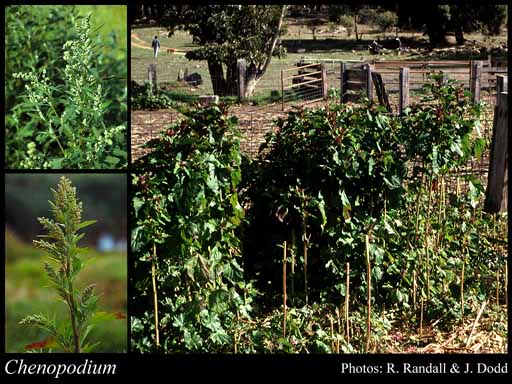- Reference
- Sp.Pl. [Linnaeus] 2:218 (1753)
- Name Status
- Current

Scientific Description
Common name. Goosefoot. Family Chenopodiaceae.
Habit and leaf form. Shrubs, or herbs. Plants succulent, or non-succulent; unarmed. Annual, or perennial. Leaves cauline. Plants with a basal concentration of leaves, or with neither basal nor terminal concentrations of leaves. Stems not ‘jointed’. Stem internodes solid. Helophytic to xerophytic. Leaves minute to large; alternate; spiral, or distichous; ‘herbaceous’, or fleshy; petiolate; aromatic, or without marked odour, or foetid; simple; epulvinate. Leaf blades dissected to entire; flat; ovate to orbicular; when incised, pinnatifid; pinnately veined; hastate, or sagittate, or attenuate at the base, or cuneate at the base. Leaves without stipules. Leaf blade margins entire, or serrate, or dentate. Leaves without a persistent basal meristem. Leaf anatomy. Hydathodes present, or absent. Hairs present, or absent (rarely); glandular hairs absent, or present. Branched hairs absent (unicellular and multicellular hairs). Extra-floral nectaries absent.
Reproductive type, pollination. Fertile flowers hermaphrodite, or functionally male and functionally female. Unisexual flowers present, or absent. Plants hermaphrodite, or monoecious.
Inflorescence and flower features. Flowers aggregated in ‘inflorescences’; in spikes, or in panicles, or in fascicles (or clusters). The terminal inflorescence unit cymose. Inflorescences terminal, or axillary (usual); the terminal flower of the inflorescence is often male or bisexual, the lateral flower female. Flowers pedicellate, or sessile; ebracteate; ebracteolate; minute, or small; regular; cyclic. Hypogynous disk present, or absent; when present, saucer-shaped. Perianth sepaline; 3–5; 1 -whorled; joined (imbricate); fleshy, or non-fleshy; persistent; accrescent, or non-accrescent. Calyx present (in both bisexual and female flowers); not replaced by accrescent bracteoles; 3–5; gamosepalous; blunt-lobed; imbricate; green; non-fleshy; persistent (in the fruit); accrescent, or non-accrescent. The fruiting calyx not berrylike; wingless, spineless and without tubercles. Calyx lobes obtuse and concave or rarely acute and erect. Corolla absent. Fertile stamens present, or absent. Androecial members definite in number. Androecium 1–5. Androecial members free of the perianth, or adnate (to the base of the perianth); all equal; free of one another, or coherent (all fused to each other at base); when coherent 1 - adelphous (connate at the base); 1 -whorled. Androecium exclusively of fertile stamens. Stamens 1–5; all more or less similar in shape; isomerous with the perianth; oppositisepalous. Anthers bent inwards in bud; dehiscing via longitudinal slits; tetrasporangiate. Fertile gynoecium present, or absent (from male flowers). Gynoecium (2–)5 carpelled. The pistil 1 celled. Gynoecium syncarpous; synovarious to synstylovarious; superior. Ovary unilocular; 1 locular. Gynoecium stylate. Styles 1–2(–3); partially joined; apical. Stigmas 2–3(–5). Placentation basal. Ovules in the single cavity 1; pendulous, or ascending; non-arillate; campylotropous.
Fruit and seed features. Fruit fleshy (rarely), or non-fleshy; indehiscent; capsular-indehiscent, or a berry; 1 celled. Gynoecia of adjoining flowers combining to form a multiple fruit, or not forming a multiple fruit. Fruit 1 seeded. Seeds more or less non-endospermic. Perisperm present, or absent. Cotyledons 2. Embryo curved (annular to horseshoe shaped).
Etymology. From the Greek for "goose" and "foot"; refers to the shape of the leaves of some species.